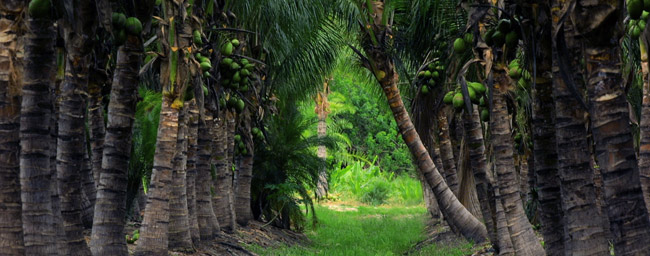Palm Tree Farm

Palm trees are symbols of rest and relaxation.
And they’re not all 80 feet tall with dangling coconuts!
At Palmco’s palm tree farm, you’ll discover many rare and hard-to-find species in various heights, colors and textures that will add depth to any landscape.
With over 600 acres in production in Bokeelia on Pine Island, Florida, Palmco is one of the largest palm plantations in North America.
We are known throughout the industry for our happy and healthy FF-grade palms, our environmentally conscious growing process, and an outstanding level of customer service.
Our team can source almost anything you need, from rare wholesale magnolias and live oaks to shady ladies, sea grapes, and other quality plants.
Of course, the treess you choose will depend on the aesthetics you’re after, your customer’s budget, and the maneuverability of the plants into the landscape.
Does your client need a mature tree or can they wait for it to grow?
Small palms cost less; large, mature palms cost more. And large palms will require a crane to move them to the site.
Differences in Palm Fronds
You should be able to differentiate most palms by their fronds:
- Pinnate leaves, or “feather” leaves, generally have two rows of leaflets that resemble feathers on each side of the stem. Examples of the pinnate palms we grow include Adonidia, Areca, Canary, Dwarf Sugar, King Alexander, Mule, and Reclinata palms.
- Palmate leaves, or “fan” leaves, have leaflets that radiate from the base of the leaf. They resemble an open hand with fingers radiating out from its palm. Many cold-hardy palms have palmate leaves, including our Caranday, Chinese Fan, European Fan, Lady, Nitida, Roebelenii (or Pygmy Date), and Windmill palms.
- Other variations include costapalmate, bipinnate, simple, bifid, or, in some cases, a completely irregular leaf shape. Our Silver Bismarckia is an example of a costapalmate palm, while the Fishtail palm has bipinnate leaves.
Palm Tree Growth & Fruits
Palms grow in two different patterns – Solitary or Clustering.
A solitary palm has one tall, straight trunk like a column, with new leaves coming from the top.
Clustering palms grow new stems at ground level, but the stems are attached together in a clump and are part of a single plant. Multi-trunk species of palm trees are usually shorter than single trunk species. Our clustering palms include the Areca, Dwarf Sugar, Fishtail, Lady and Paurotis palms.
Most palm trees flower and, if pollinated, will produce fruits, the most well-known being dates and coconuts. The date palm may produce up to 500 pounds of sweet, brown dates each year and live for up to 100 years.
The only palm tree that produces coconuts is the Coconut Palm, also known as the Cocos nucifera.
It loves warm, humid weather between 70°F and 100°F. In the U.S., the species only survives in Hawaii, some areas of Texas, and in south Florida. An unexpected frost or weather that dips below 70°F can seriously stunt the growth of this palm and prevent it from producing coconuts.
We grow only the highest quality Jamaican Certified Cocos nucifera seeds because they are resistant to Lethal Yellowing disease.
Whether you are creating a tropical paradise or just need a few showstoppers, Palmco has a massive inventory of palms for sale.
We welcome you to tour our palm tree farm in Florida to find out what sets us apart from other nurseries. Contact us at (239) 283-1329 or (855) GOPALMCO for answers to any questions you may have about palms or bamboos.

